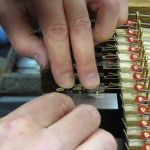PRINCIPLES AND PRACTICALITIES
Here is some background information for those who are not familiar with the world of organ building.
A Glossary of organ terminology can be found HERE.
Principles
 Pipe organs, like people, are “fearfully and wonderfully made”; they have a long history and a vast musical repertoire. Records of organs in England go back to the eighth century. Before 1539 there were five organs in Durham Cathedral, and the organ “ouer the quire dore” was said to be one of the finest in the country. Today an organ in a village church might have up to 1000 pipes; the Harrison & Harrison organ in Durham Cathedral has 5734 pipes, varying from 32ft long to the size of a pencil.
Pipe organs, like people, are “fearfully and wonderfully made”; they have a long history and a vast musical repertoire. Records of organs in England go back to the eighth century. Before 1539 there were five organs in Durham Cathedral, and the organ “ouer the quire dore” was said to be one of the finest in the country. Today an organ in a village church might have up to 1000 pipes; the Harrison & Harrison organ in Durham Cathedral has 5734 pipes, varying from 32ft long to the size of a pencil.
Organ building has been aptly described as “engineering in wood”, requiring skill and artistry in equal measure. The organ is not only a mechanical marvel but is first and foremost a musical instrument, and each organ is unique in sound, layout and size, depending on the acoustic, the position in the building, and what it will be used for. The specification is planned in accordance with the musical and spatial requirements; the voicer translates this into families of pipes of a suitable scale, which are made in our own metal shop, and the designer develops a workable layout, with casework to complement the building.
Organ builders are skilled craftsmen, working with wood, leather, and metal for pipes. The sound is created by wind at a chosen pressure which has travelled from the bellows (or reservoir) to the wind chest (or soundboard) on which the pipes stand. The keyboard is linked to the wind chest by either (1) tracker action (direct mechanical linkage), or (2) pneumatic action (puffs of wind operated by miniature bellows, or ‘motors’), or (3) electro-pneumatic action (‘motors’ assisted by magnets).

The drawstops operate sliders in the soundboard allowing wind to enter the selected rank of pipes. Larger organs have electronic interface at the console to assist the organist in selecting stops to create different colours of sound for musical performance.
The various components are made in the workshop, using hand-tools and wood-working machines, and each organ is assembled to ensure that everything fits perfectly before being dismantled and transported to its destination. Finally, the voicers create the special musical architecture which will harmonise with that particular building.
PracticalitiesHarrison & Harrison’s approach to organ building is nothing if not thorough.
Every organ is designed individually for its specific building, to fit both the acoustics and the architecture; and great care is taken to ensure that each organ has a logical and accessible internal layout. Harrisons use Computer Aided Design (CAD), which has the advantage of ease in producing accurate, detailed working drawings, and allows our designers to experiment with a variety of layouts.

We make our own organs in our own workshop.
Nothing is mass-produced: not a single tracker or power-motor is made without a particular organ in mind. There are no short cuts.
The firm has an unbroken tradition of slider chests, going back to 1861.
We cast our own pipe metal by traditional methods to the specification required for each stop.
The firm’s own voicers control every aspect of the organ’s musical development.
Each new organ is first set up in our workshop to ensure that every part is functioning correctly. It is then dismantled and packed for dispatch.
After it has been installed by our own organ builders, the instrument is finished with the detailed voicing and tonal blending for which the firm is renowned.
Harrison organs have a reputation for longevity. A new organ is guaranteed for the first fifteen years;
even after that it will require little attention. A busy city church could expect its H&H organ to run smoothly for
50 years before its first major maintenance work. A small country organ might last twice as long.